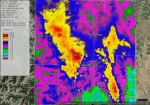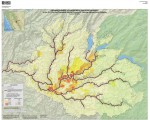Friday, November 15th, 2013
A new study based on Earth-observing satellite data comprehensively describes changes in the world’s forests from the beginning of this century. Published in Science today, this unparalleled survey of global forests tracked forest loss and gain at the spatial granularity of an area covered by a baseball diamond (30-meter resolution).
Wednesday, November 13th, 2013
Many environmentalists today miss the broader political picture by advocating for small day-to-day “green living” acts that in reality are far more symbolic than they are effective. The truth is that most people are proponents of a cleaner environment, safer products and labor conditions, and a better functioning democracy-they are just not actively working together
Monday, November 11th, 2013
Scientists using sophisticated statistical methods show in a paper in Nature Geoscience that the successful phase out of chlorofluorocarbons, or CFCs, by the Montreal Protocol slowed climate change, contributing to a lower rate of global warming since the early 1990s.

Sunday, November 10th, 2013
On September 10, 2013, what would become a devastating situation, began with an inch of rain falling in Boulder, Colorado. The following day saw another inch, and the rain continued to come down for several more days after that. Only six days later on September 16, some Community Collaborative Rain, Hail, and Snow Network (CoCoRaHS)

Friday, November 8th, 2013
Although dousing the flames was foremost in people’s minds during the recent Rim Fire in Stanislaus National Forest and Yosemite National Park, U.S. Geological Survey scientific work continues well after the fire is out. USGS scientists are continuing their critical research characterizing the hidden dangers faced after large wildfires.
Wednesday, November 6th, 2013
The gap continues to grow between emissions pledges that countries have made and the emissions levels needed by 2020 to keep global temperature rise below 2° (or 1.5°) C by 2100.
Wednesday, November 6th, 2013
Although remote sensing has been used in conservation for many decades, its huge potential remains unlocked. Remote sensing continues to advance at a frightening pace along with other technologies such as cloud computing and parallel processing. These advances mean we can now handle and manipulate enormous datasets at extremely low cost and high speed, at
Tuesday, November 5th, 2013
Cutting short-lived climate pollutants (SLCPs) can significantly reduce warming in vulnerable ice and snow covered areas of the world such as the Arctic and Himalayas, known as the cryosphere, while saving millions of lives and protecting ecosystems, according to a new scientific study released today.
Monday, November 4th, 2013
The U.S. Environmental Protection Agency (EPA) today released its draft Climate Change Adaptation Implementation Plans for public review and comment. In support of President Obama’s Climate Action Plan and Executive Order on Preparing the United States for the Impacts of Climate Change announced today, the Implementation Plans provide detailed information about the actions EPA plans
Sunday, November 3rd, 2013
Understanding Earth’s dynamic climate requires knowledge of more than just greenhouse gases. One of the key measurements scientists measure is reflected solar radiance, or the amount of outgoing sunlight energy scattered from Earth’s surface and atmosphere. Watching solar radiances over time helps scientists gauge and better understand environmental changes like global warming.